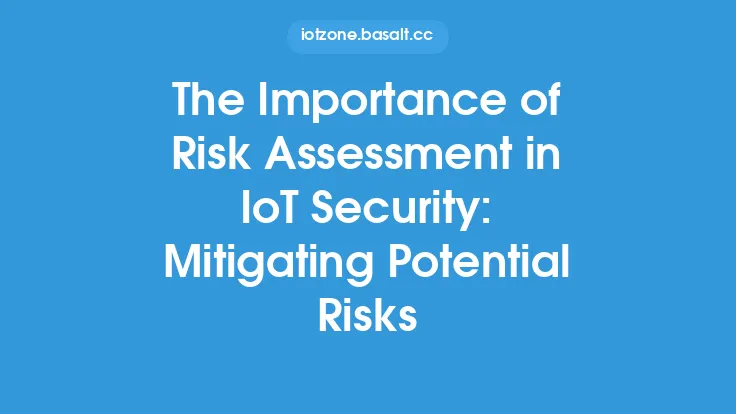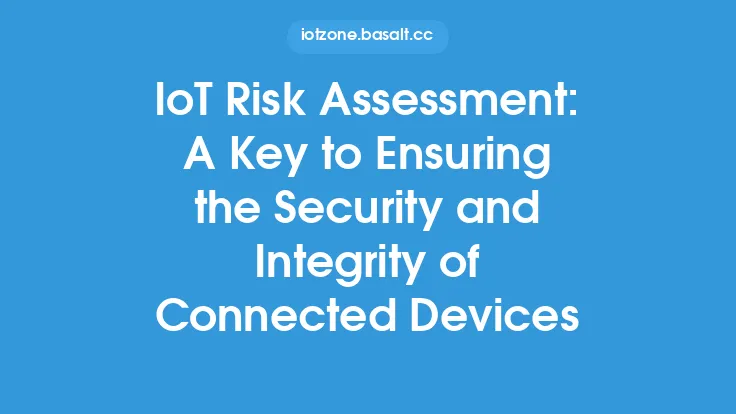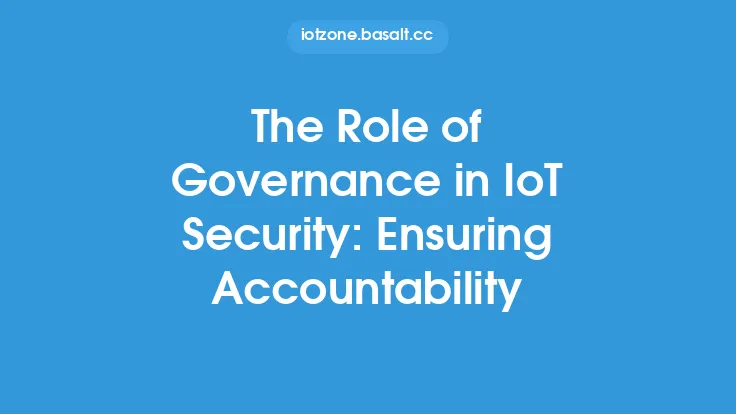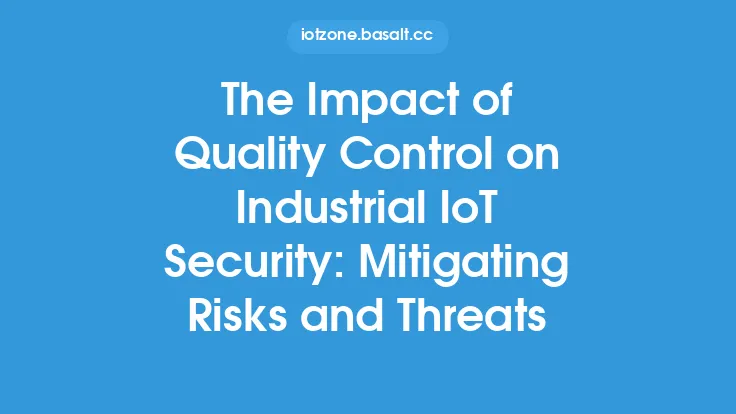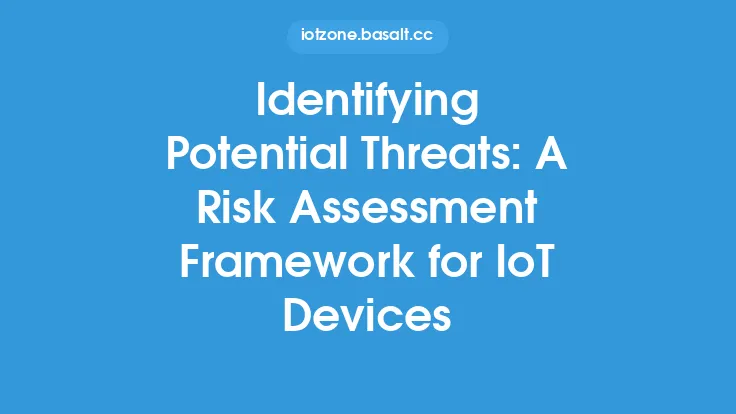The increasing number of connected devices in the Internet of Things (IoT) has created a vast and complex ecosystem that is vulnerable to various security threats. As the IoT continues to grow and expand into different aspects of our lives, the need for robust security measures has become more pressing than ever. One crucial aspect of IoT security is risk assessment, which involves identifying, evaluating, and prioritizing potential risks to prevent or mitigate attacks. In this article, we will delve into the role of risk assessment in IoT security, exploring its importance, methodologies, and best practices for protecting against emerging threats.
Introduction to Risk Assessment in IoT Security
Risk assessment is a systematic process that helps organizations understand and manage the risks associated with their IoT systems. It involves analyzing the potential vulnerabilities and threats that could compromise the confidentiality, integrity, and availability of IoT devices and data. The goal of risk assessment is to identify and prioritize potential risks, allowing organizations to allocate resources effectively and implement targeted security measures to mitigate or prevent attacks. In the context of IoT security, risk assessment is essential for ensuring the security and integrity of connected devices, as well as protecting against emerging threats that could have significant consequences.
Methodologies for IoT Risk Assessment
There are several methodologies that can be used for IoT risk assessment, including the National Institute of Standards and Technology (NIST) framework, the International Organization for Standardization (ISO) 27001 standard, and the Factor Analysis of Information Risk (FAIR) framework. These methodologies provide a structured approach to risk assessment, helping organizations to identify, evaluate, and prioritize potential risks. The NIST framework, for example, provides a comprehensive approach to risk management, including risk assessment, risk mitigation, and continuous monitoring. The ISO 27001 standard, on the other hand, provides a set of requirements for establishing, implementing, maintaining, and continually improving an information security management system (ISMS).
Identifying Potential Threats and Vulnerabilities
Identifying potential threats and vulnerabilities is a critical step in the risk assessment process. This involves analyzing the IoT system's architecture, components, and data flows to identify potential weaknesses and vulnerabilities. Some common threats and vulnerabilities in IoT systems include device vulnerabilities, network vulnerabilities, data breaches, and denial-of-service (DoS) attacks. Device vulnerabilities, for example, can occur due to outdated software, weak passwords, or insecure communication protocols. Network vulnerabilities, on the other hand, can occur due to inadequate network segmentation, weak firewalls, or insecure routing protocols.
Evaluating and Prioritizing Risks
Once potential threats and vulnerabilities have been identified, the next step is to evaluate and prioritize risks. This involves assessing the likelihood and potential impact of each risk, as well as the effectiveness of existing security controls. The risk assessment process should consider factors such as the potential consequences of a security breach, the likelihood of a threat occurring, and the effectiveness of existing security measures. Risks can be prioritized based on their severity, with high-risk vulnerabilities requiring immediate attention and mitigation.
Implementing Risk Mitigation Measures
After risks have been evaluated and prioritized, the next step is to implement risk mitigation measures. This can include a range of security controls, such as firewalls, intrusion detection systems, encryption, and secure communication protocols. Implementing risk mitigation measures requires a thorough understanding of the IoT system's architecture and components, as well as the potential threats and vulnerabilities. It is also essential to continuously monitor and evaluate the effectiveness of risk mitigation measures, making adjustments as needed to ensure the security and integrity of the IoT system.
Continuous Monitoring and Evaluation
Continuous monitoring and evaluation are critical components of the risk assessment process. This involves regularly reviewing and updating the risk assessment to ensure that it remains relevant and effective. Continuous monitoring can help identify new threats and vulnerabilities, as well as changes in the IoT system's architecture or components. It can also help evaluate the effectiveness of risk mitigation measures, making adjustments as needed to ensure the security and integrity of the IoT system.
Best Practices for IoT Risk Assessment
There are several best practices that organizations can follow to ensure effective IoT risk assessment. These include:
- Conducting regular risk assessments to identify and prioritize potential risks
- Implementing a comprehensive risk management framework that includes risk assessment, risk mitigation, and continuous monitoring
- Using a structured approach to risk assessment, such as the NIST framework or the ISO 27001 standard
- Continuously monitoring and evaluating the effectiveness of risk mitigation measures
- Providing training and awareness programs for employees and stakeholders on IoT security and risk assessment
- Establishing incident response plans and procedures to respond to security breaches and incidents
Emerging Trends and Challenges in IoT Risk Assessment
The IoT landscape is constantly evolving, with new devices, technologies, and threats emerging all the time. Some emerging trends and challenges in IoT risk assessment include the increasing use of artificial intelligence (AI) and machine learning (ML) in IoT systems, the growth of the industrial internet of things (IIoT), and the increasing importance of edge computing. These trends and challenges require organizations to adapt and evolve their risk assessment approaches, using new methodologies and tools to identify and mitigate potential risks.
Conclusion
Risk assessment is a critical component of IoT security, helping organizations to identify, evaluate, and prioritize potential risks. By using a structured approach to risk assessment, such as the NIST framework or the ISO 27001 standard, organizations can ensure the security and integrity of their IoT systems. Implementing risk mitigation measures, continuously monitoring and evaluating the effectiveness of these measures, and providing training and awareness programs are all essential best practices for effective IoT risk assessment. As the IoT landscape continues to evolve, it is essential for organizations to stay up-to-date with emerging trends and challenges, adapting and evolving their risk assessment approaches to ensure the security and integrity of their IoT systems.

